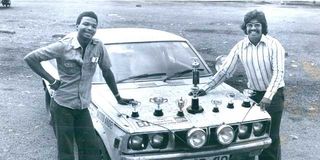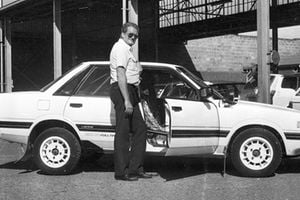
Kibathi Muigai (left) and his navigator Arshad Khan stand besides his Colt Galant GTO in 1978, the year he memorably competed in his debut year, 1978.
Many young rally fans may not be familiar with name of veteran driver Kibathi Muigai who passed on last week aged 72. He will be interred at his Ichaweri home in Gatundu, Kiambu tomorrow.
Muigai, also popular known as Wa Ngina, was a prominent businessman from the Kenyatta family, brother to legislator Beth Mugo and cousin of former President Uhuru Kenyatta. However, he was better known for his rallying exploits.
He came in the 1978-79 rally season fast and furious, then exited the stage abruptly after displaying a rare talent not seen by any other indigenous African driver before that threatened to disrupt the established order of the whites-dominated rally scene.
He became the first African driver to finish top-three in Kenya National Rally Championship events, claiming position two in the 1978 Mombasa Motor Club Championship. That same year, he finished third in the Firestone Rally Championship (KNRC) and fourth in the Kisumu Rally.
Patrick Njiru was the second African driver to achieve a podium finish, coming in second in the 1984 BP Visco 2000 Rally. Njiru went on to win five KNRC rallies.
Others African drivers who have finished top-three in KNRC events are the late Jonathan Torotich and recently, youngsters Jeremiah Wahome and McRae Kimathi.
Muigai was a young man about town who matched his driving skills with his well-kept bad boy signature dreadlocks looks, rare in those days as they cut a rebellious image.
His first rally was stuff of legends as told by his first and only navigator in his two years of rallying, Arshad Khan, when he recorded second, third and fourth place finishes in the clubman and national championships of 1978-79 including two memorable drives in the Safari Rally.
Arshad, a senior partner of the helicopter leasing service, ALS, said he left as fast as he came due to pressure of work as nobody in those days lived on motorsport. There were no commercial sponsorships or an industry which supported motorsport then unlike today.
Through the voice of Arshad, still an active driver, at 70 years, in Classic events, he tells of Kibathi’s story so vividly as if it was yesterday.
“Kibathi was a very good young man, brave, very fast and focused. My chance meeting was also dramatic, and I believe Kibathi could have set or broken records,” said Arshad yesterday in a video interview organised by Kibathi’s nephew and rally official, Maina Muturi, whose son, Tutu Maina took after his grandfather in motorcycle competitions two decades later.
“In 1977 I was to drive in the Safari Rally with Najimi Kassam, and before the Safari he went out to test the Datsun, rolled and broke his arm. I was very disappointed as nothing mattered to me than rallying then as I was only 25.
“Then that year I met a friend who advised that there was a young African man full of energy, and wants to rally, but was in Mombasa because working in the oil industry and was looking for a navigator.
“He did not have a navigator for a Clubman event which was going to be held there on a Saturday afternoon. It was 300km long and I was called on Friday night through a neighbour’s phone and you know those days communication was not as clear as today.
“I was told to get on the first flight to Mombasa that Saturday. So, I took the next flight from Nairobi to Mombasa to navigate Kibathi. I did not know him and had never even seen him before. There were 15 car entries, you know this was just a small Mombasa Motorsports Club rally.
“The car was a standard Colt Galant GTO. I asked him if the zero-trip in the speedometer was working. ‘Why don't you go and check it,’ he replied. So, I went and sat in the car and found it was working. He hit off nicely.
“We started in 12th position and by the halfway stage I think we were lying fifth on the road and by the evening at about 9pm at Dolphin Hotel we were the second car on the road.
“This made Kibathi excited. And I saw then, he was a very fearless driver and full of energy. I don’t know what happened, but I remembered the car hitting something and jumping about five or seven feet in the air but when we landed, the four suspensions punched four holes through the car. Luckily, we were within the finish line and ended the rally in second position overall.”
From Mombasa, they decided to do their first national rally, the Firestone Rally, organised by the East African Motorsports Club in 1978 when Muigai made history as the first indigenous African driver to finish on the podium, a third behind very experienced drivers led by the winner Rob Collinge and Anton Levitan in a Raid Alfa followed by Bruce Field and B.Botha in a Datsun.
“After Mombasa we got new suspensions and tuned the car well for the next event that started and finished at the Golf Range Hotel, now Carnivore Restaurant. The rally started on Saturday night and finished at 10am on Sunday. We fought hard and overtook so many cars that at the finish we were lying in third position overall.
“But at the prize giving at about 4pm we were told that there was no trophy for third position, but we would be given the most meritorious award for Kibathi’s historic result, which had never been achieved by a black African before.
“That is the day I knew the other side of Kibathi. He got into an argument with Jack Simonian who was the clerk-of-the-course and within two minutes the whole Golf Range got empty. Everybody ran away as Kibathi ran amok. I think the dreadlocks must have scared everybody, thinking he was a Mau Mau. He was so mad wondering which competition in the world did not have a third position trophy.”
From then hence forth, the Colt Lancer became a regular feature outside the Cameo Cinema in Kenyatta Avenue parking bay where his uncle was running the cinema and the popular verandah bar.
Muigai did not finish the 1978 and 1979 Safari Rally but made up for that with a third place finish in the 1979 African Safari Airways Rally driving his trusted Colt Lancer behind Mike Kirkland (Datsun 160J) and Ashok Bhalla (Daihatsu Charmant).






